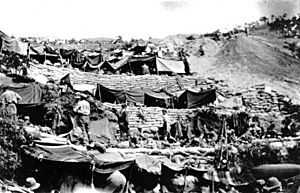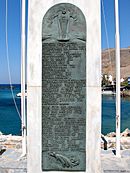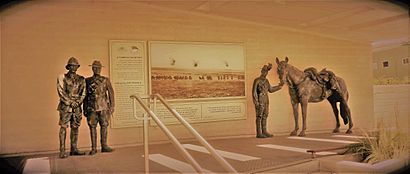Australian and New Zealand Army Corps facts for kids
Quick facts for kids Australian and New Zealand Army Corps |
|
|---|---|

New Zealand soldiers' encampment at ANZAC Cove in 1915
|
|
| Active | 1914–1916; 1941 |
| Countries | |
| Branch | Army |
| Type | Administrative Corps |
| Part of | Mediterranean Expeditionary Force |
| Nickname(s) | ANZAC |
| Anniversaries | Anzac Day |
| Engagements | First World War Second World War Vietnam War |
| Commanders | |
| Notable commanders |
William Birdwood |
The Australian and New Zealand Army Corps (ANZAC) was a special group of soldiers. It was formed during the First World War. This group was part of the Mediterranean Expeditionary Force.
ANZAC was created in Egypt in December 1914. Its soldiers fought bravely in the Gallipoli campaign. General William Birdwood led this corps. Most of the soldiers were from Australia and New Zealand. However, some British and Indian units also joined them at different times.
The ANZAC corps was officially ended in 1916. This happened after the Allied forces left the Gallipoli peninsula. After this, two new groups were formed: I ANZAC Corps and II ANZAC Corps. The ANZAC corps was briefly brought back during the Second World War in 1941. This was during the Battle of Greece.
Contents
How ANZAC Was First Formed
Plans to create ANZAC started in November 1914. At this time, the first groups of Australian and New Zealand soldiers were traveling by ship. They thought they were going to Europe.
However, it was decided that they should not spend the winter in England. There was not enough housing or equipment there. So, the ships were sent to Egypt instead. The soldiers trained in Egypt before moving on to the Western Front in France.
The British Secretary of State for War, Horatio Kitchener, chose General William Birdwood to lead the corps. General Birdwood was an officer from the British Indian Army. He brought many staff members from the Indian Army to help him. Birdwood arrived in Cairo on December 21, 1914, to take command.
At first, they planned to call the group the Australasian Army Corps. This name was used because New Zealanders and Australians often competed together as Australasia in sports. But New Zealand soldiers complained. So, the name Australian and New Zealand Army Corps was chosen instead.
The people who handled the paperwork found this name too long. They quickly started using the short form: A. & N.Z.A.C. or simply ANZAC. Soon after, ANZAC became the official short name for the corps. However, the soldiers themselves did not use the name much until after the Gallipoli landings.
When it first started, the corps had two main parts, called divisions. These were the Australian Division and the New Zealand and Australian Division. The Australian Division had three infantry brigades. The New Zealand and Australian Division had infantry, mounted troops, and another Australian infantry brigade. There were also other Australian mounted brigades that worked with the whole corps.
Even though ANZAC is known for Australia and New Zealand, it had soldiers from many different countries. Besides British officers, the corps included:
- Indian Mountain Artillery
- Troops from Ceylon Planters Rifle Corps
- The Zion Mule Corps
- Soldiers from the Royal Naval Division
- Parts of the British 13th (Western) Division
- A brigade from the British 10th (Irish) Division
- The 29th Indian Brigade
Later Formations
World War I
After leaving Gallipoli in December 1915, the Australian and New Zealand units gathered again in Egypt. The New Zealand soldiers formed their own division, called the New Zealand Division.
The First Australian Imperial Force was also reorganized. This led to the creation of two new Australian divisions: the 4th and 5th divisions. (The Australian 3rd Division was being formed in Australia and would go straight to France.)
These divisions were then put into two new corps: I ANZAC Corps and II ANZAC Corps. I ANZAC Corps, led by General Birdwood, went to France in early 1916. II ANZAC Corps, led by Lieutenant General Alexander Godley, followed soon after.
In January 1916, the 4th (ANZAC) Battalion of the Imperial Camel Corps was formed. It had Australian and New Zealand soldiers. The 1st and 3rd Battalions were Australian, while the 2nd Battalion was British. In March 1916, the ANZAC Mounted Division was created. It had three Australian brigades and one New Zealand brigade. This division served in Egypt and Palestine. There was also the 1st (ANZAC) Wireless Signal Squadron. It worked with the British forces in Mesopotamia from 1916 to 1917.
In early 1916, the Australian and New Zealand governments wanted to create a larger "Australian and New Zealand Army." This army would have included all the Australian and New Zealand infantry divisions. However, this plan did not happen.
World War II
During World War II, the Australian I Corps headquarters moved to Greece in April 1941. Because this corps also controlled the New Zealand 2nd Division (along with Greek and British groups), it was officially renamed ANZAC Corps in April.
The Battle of Greece ended quickly, in just a few weeks. The corps headquarters left Greece on April 23–24. After this, the name ANZAC Corps was no longer used.
Some soldiers were sent to Alexandria. But most went to Crete to make its defenses stronger. They expected a German invasion by air and sea. Australian and New Zealand soldiers were placed around the cities of Rethymno and Chania in western Crete. A smaller Australian group was in Heraklion.
The invasion began on the morning of May 20. After the fierce Battle of Crete, which lasted ten days, Crete fell to the Germans. Most of the soldiers defending Chania moved across the island to the south coast. They were then taken away by the Royal Navy from Sfakia. Many others avoided capture for several months. They hid in the mountains with help from the local Cretan people. Some who were captured and sent to Axis prisoner-of-war camps in Europe managed to escape on the way through Yugoslavia. Those who escaped found safety with local resistance groups until they could either return home or were recaptured.
Other Conflicts
During the Vietnam War, two companies from the Royal New Zealand Infantry Regiment joined Australian battalions. These combined battalions had "(ANZAC)" added to their names. For example, 4 RAR became the 4RAR/NZ (ANZAC) Battalion. An ANZAC battalion served as one of the main infantry groups for the 1st Australian Task Force from early March 1968 until December 1971. Because soldiers rotated, there were five different combined battalions during this time.
The ANZAC Battle Group was the official name for Australian and New Zealand units sent to Timor Leste. This was part of Operation Astute. The battle group was formed in September 2006.
See also
 In Spanish: Cuerpos del ejército australiano y neozelandés para niños
In Spanish: Cuerpos del ejército australiano y neozelandés para niños





